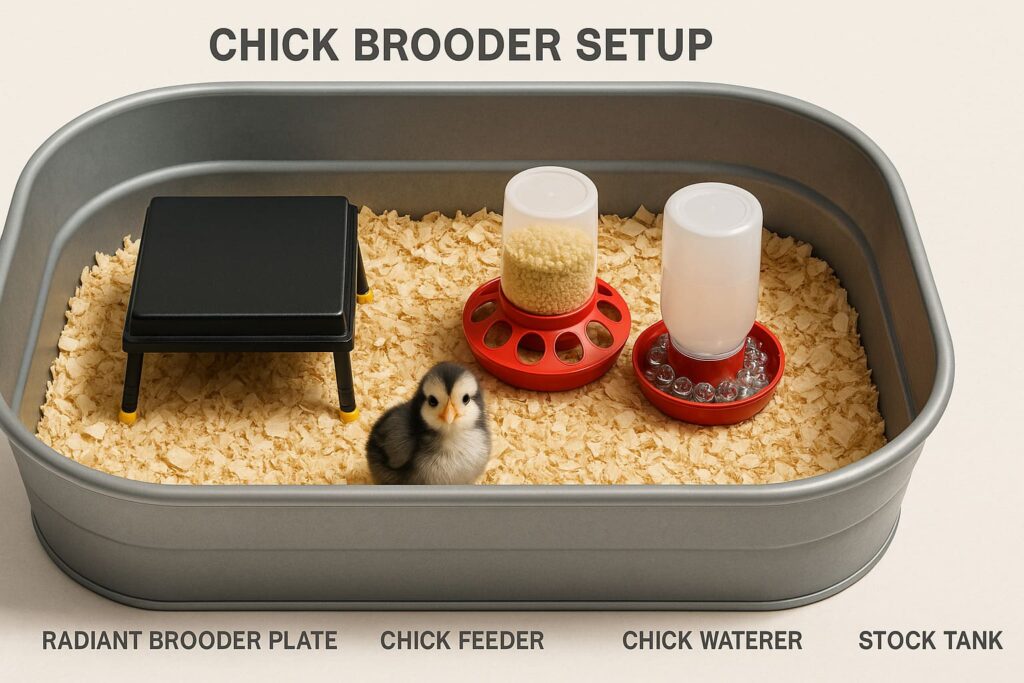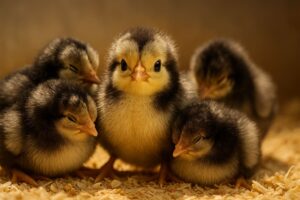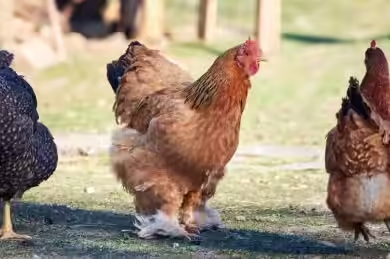Last updated on August 2, 2025
There’s nothing quite like the excitement of hearing the first tiny chirps from a box of newly arrived Wyandotte chicks, or the anticipation of a tiny beak “pipping” through an egg in your incubator. This guide provides everything a beginner needs to know to successfully raise healthy Wyandotte chicks from day one through their first few months, ensuring they grow into robust, happy members of your flock.
Wyandotte Chick Quick Facts
- Hatching Time: 21 days
- Brooder Temperature: Start at 95°F (35°C)
- Feed Type: 20-22% protein “Chick Starter”
- Ready for Coop: 8-10 weeks (when fully feathered)
- Sexing: Best done after 6-8 weeks by observing comb and feather growth
Your Wyandotte Chick Brooder Shopping List
To get started, here is a concrete shopping list for setting up your brooder.
- ✅ Container: A 50-gallon plastic tote or a galvanized stock tank (at least 2 ft tall).
- ✅ Heat Source: A 250-watt infrared heat lamp OR a radiant brooder plate (safer option).
- ✅ Bedding: One large bag of pine shavings (NOT cedar).
- ✅ Feeder: One quart-sized chick feeder.
- ✅ Waterer: One quart-sized chick waterer. For the first week, add marbles or pebbles to the trough to prevent drowning.
- ✅ Feed: One bag of 20-22% protein “Chick Starter” crumbles.
- ✅ Electrolytes & Probiotics: (Optional but recommended) To add to water for the first few days to combat shipping stress.
Hatching Wyandotte Eggs: The 21-Day Countdown
If you’re starting with hatching eggs, remember that consistency is key. Like all chicken breeds, Wyandotte eggs take approximately 21 days to hatch under proper conditions.
Here are the incubator basics you need to follow for a successful hatch:
- Temperature: Maintain a steady 99.5°F (37.5°C).
- Humidity: For the first 18 days, keep the humidity between 45-50%. On day 18, increase it to 65-70% for “lockdown.”
- Egg Turning: Turn the eggs at least three times a day for the first 18 days. Stop all turning when you enter lockdown to allow the chicks to position themselves for hatching.
The Brooder: Your Chick’s First Home
A brooder is a safe, warm environment that mimics a mother hen. Your chicks will live here until they are fully feathered and can regulate their own body temperature, typically around 6-8 weeks of age.

Brooder Checklist
- Container: A large plastic tote, a galvanized stock tank, or even a sturdy cardboard box works well. Ensure the sides are tall enough to prevent chicks from flying out as they get older.
- Heat Source: A heat lamp or, for a safer alternative, a brooder plate. While heat lamps are a traditional choice, they pose a fire risk and can be too intense. A brooder plate is safer and allows chicks to huddle underneath for warmth just as they would with a mother hen.
- Bedding: Use pine shavings. Avoid cedar shavings, which can be toxic to chicks and cause respiratory issues. For the first few days, a layer of paper towels on top of the shavings can help prevent them from eating the bedding.
- Food & Water: Provide a chick starter feed in a small, easily accessible feeder and a shallow waterer to prevent drowning. It’s crucial to have the right number of feeders and drinkers for the number of chicks you have to prevent crowding and ensure everyone can eat and drink without stress.
The First 8 Weeks: A Comprehensive Care Timeline
Weekly Growth & Care Timeline
This timeline provides a clear roadmap for what to expect and what to do during the critical first few weeks.
| Week | Key Task / Milestone | Brooder Temperature | Feed Type |
|---|---|---|---|
| Week 1 | Monitor for pasty butt. Ensure chicks are eating & drinking. | 95°F (35°C) | Chick Starter |
| Week 2 | Remove paper towels (if used). Provide more space if needed. | 90°F (32°C) | Chick Starter |
| Week 3 | Feathers are growing rapidly. Watch for early signs of pecking. | 85°F (29°C) | Chick Starter |
| Week 4 | Chicks are very active. Consider adding a small roosting bar. | 80°F (27°C) | Chick Starter |
| Week 5-6 | Start looking for early sexing traits (comb/wattle growth). | 75°F (24°C) | Chick Starter |
| Week 7-8 | Begin transitioning from Chick Starter to Grower feed. | Ambient Temp | Starter/Grower Mix |
| Week 8+ | Chicks are fully feathered and ready to transition to the main coop. | Ambient Temp | Grower Feed |
The First 4 Weeks: A Guide to Critical Care
The first month of a chick’s life is the most critical period for their development.
- Feeding: Your chicks need a high-protein feed to grow. Use a “chick starter” feed that is 20-22% protein. This ensures they have the energy and nutrients for rapid feather growth.
- Temperature Management: Start the brooder temperature at 95°F for the first week. After that, decrease the temperature by 5 degrees each week until it matches the ambient temperature. Watch the chicks’ behavior—if they huddle under the heat, they are too cold; if they are pushed to the edges, they are too hot.
- Monitoring for Health Issues: The first week is the most critical. Being able to spot trouble early is key to preventing losses. Familiarize yourself with the top 10 reasons day-old chicks die to avoid common pitfalls. Be on the lookout for:
- Pasty Butt: This is when droppings dry and stick to a chick’s vent, preventing it from passing waste. Gently clean it with a warm, damp paper towel. Never pull at the dried droppings, as this can injure the chick.
- Lethargy/Not Eating: A chick that is listless or not eating is a sign of a potential health problem.
Transitioning to Grower Feed
Around 6 to 8 weeks of age, once your chicks are well-established and growing quickly, you can transition them from a high-protein chick starter to a “grower” feed. Grower feed typically has a slightly lower protein content (16-18%) and is designed to support steady growth without pushing them into laying too early. Mix the two feeds together for a week to make the transition smooth.
How to Tell a Wyandotte’s Gender (The 8-Week Rule)
The question of how to tell if a Wyandotte chick is male or female is a common one for new keepers. The short answer is that Wyandottes are not an auto-sexing breed, meaning you can’t tell the sex at a glance. Vent sexing is a highly skilled technique that should be left to professionals.
However, as your chicks grow, you can make a highly educated guess by looking at three key areas. While no single method is 100% foolproof for beginners, by 8 weeks old, these observable differences become much clearer.
- The Comb (80% Confidence): Look at the comb and wattles. A cockerel’s (young male’s) will be noticeably larger, thicker, and a brighter red than a pullet’s (young female’s), which will still be small and pale pink.
- The Feathers (70% Confidence): Examine the feathers in front of the tail. On a male, you will start to see long, shiny, pointed “saddle feathers” draping down. A female’s feathers will all be short and rounded. You may also observe subtle differences in feather patterns as they grow, which can be compared to the adult patterns in our Visual Guide to Wyandotte Chicken Colors.
- The Stance (60% Confidence): Observe their posture. Cockerels tend to stand more upright and “proud,” with thicker legs, while pullets have a more horizontal, delicate stance. Their overall frame tends to be more robust.
The Transition: Moving from Brooder to Coop
Once your Wyandotte chicks are fully feathered, usually around 8-10 weeks of age, they are ready to transition to the main coop. This is a critical step and should be done with care to ensure a smooth integration.
- Introduce Them Slowly: Set up a wire-covered “transition pen” inside the main coop. This allows the older birds to see and get used to the new chicks without direct contact.
- Watch for Bullying: Once you remove the barrier, monitor the flock closely. Minor pecking is normal as the pecking order is established, but severe bullying or bleeding is a sign you need to separate them again.
- Provide Multiple Resources: Ensure there are multiple feeding and watering stations so the new birds can eat and drink without being run off by older, more dominant hens.
Expert Tips and Troubleshooting
Expert Tips for Healthy Wyandotte Chicks
These are some simple tricks of the trade that can make a big difference in the health and happiness of your flock.
- The “Tapping” Trick: For the first hour, tap your finger in the chick feed to teach the chicks where it is. Their instinct to peck at your finger will show them how to eat.
- Prevent Drowning: For the first week, place clean marbles or small rocks in the waterer’s trough. This allows them to drink but prevents them from falling in and getting chilled or drowning.
- Roosting Practice: Add a low-level roosting bar (a simple 2×4 on its side) to the brooder after 3-4 weeks. This encourages natural roosting behavior early on.
- Fight Boredom: If you see chicks pecking at each other, it’s often a sign of boredom. Hang a small bundle of millet spray or a head of lettuce just out of reach to give them something to do.
Common Troubleshooting: What to Do When Things Go Wrong
- Chicks are Huddled Together: This usually means they are too cold. Lower the heat source or add a second one.
- Chicks are Panting and Spread Out: They are too hot. Raise the heat source or ensure there is a cool zone they can escape to.
- Chicks are Lethargic or Not Eating: This is a sign of a health issue. First, check the brooder temperature and ensure they have access to food and water. If the issue persists, you may need to consult with a veterinarian.
- Chicks are Pecking Each Other: This is a sign of boredom or overcrowding. Add some enrichment like hanging lettuce or providing more space.
Frequently Asked Questions
How long do Wyandotte chicks need a heat lamp?
Wyandotte chicks need a heat source for about 6-8 weeks until they are fully feathered and can regulate their own body temperature.
When can I let my chicks outside?
You can introduce them to the coop and outside run around 8-10 weeks of age, once they are fully feathered and the brooder temperature matches the outside temperature.
What should I do if a chick has pasty butt?
Gently clean the vent with a warm, damp paper towel. Never pull at the dried droppings, as this can injure the chick.
What’s the difference between chick starter and grower feed?
Chick starter has a higher protein content (20-22%) for rapid growth, while grower feed has a lower protein content (16-18%) for steady development before egg laying.
How do I know if my brooder is the right temperature?
Observe the chicks’ behavior. If they huddle under the heat, they are too cold. If they are pushed to the edges, they are too hot. They should be evenly spread out.
Conclusion: From Brooder to Big Coop
Successfully raising Wyandotte chicks is a rewarding experience. By providing a safe, warm brooder and the right nutrition, you will have watched them transform from fragile chicks to fully-feathered, hardy young pullets.
Once your Wyandotte pullets are fully feathered and ready to join the main flock, the next exciting milestone is their first egg. To learn exactly when they’ll start laying and what to expect, read our Ultimate Guide to Wyandotte Egg Laying.


